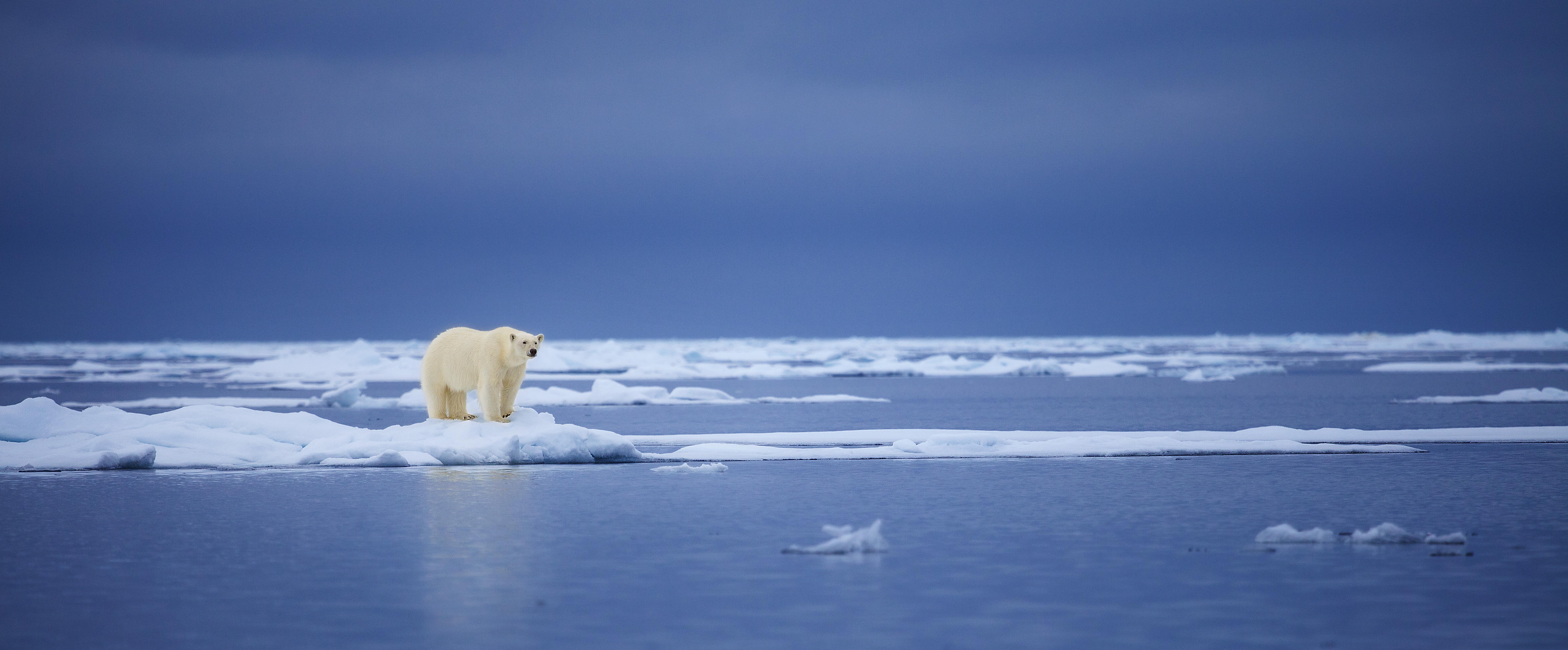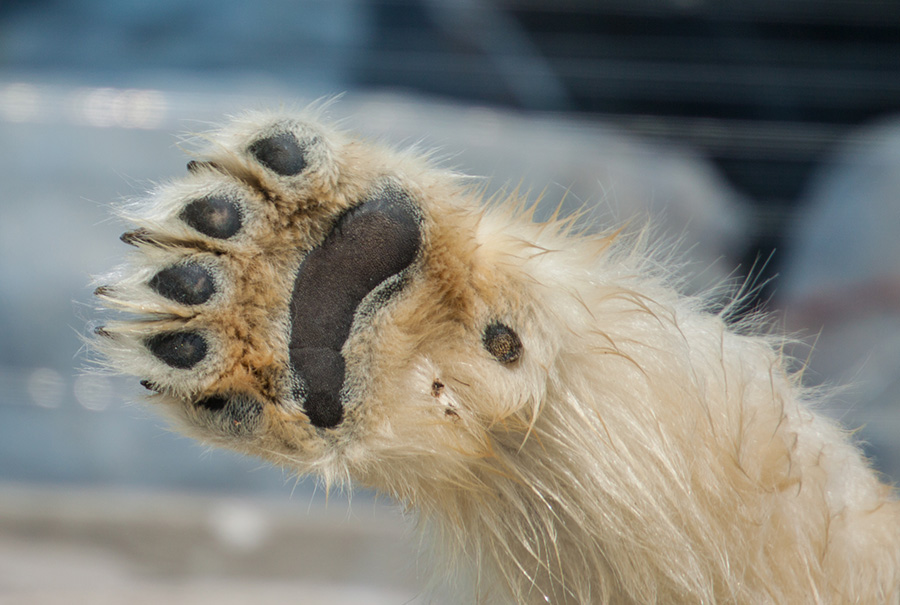UA researchers’ focus on tire traction leads to investigation of polar bear paws

Traction is important. Humans have been continually interested in discovering how to better move across wet or frozen surfaces safely – whether to improve shoes for walking on sidewalks or tires to maneuver the roadways. But what makes it possible for some arctic animals to walk and run across the ice so effortlessly and gracefully without slipping and falling? Three researchers from The University of Akron (UA) took a deep dive into the paws of polar bears to find out. Their research was published in the November issue of the Journal of the Royal Society Interface.
Why polar bears?
The project team included Ali Dhinojwala, the H.A. Morton Professor of Polymer Science in the School of Polymer Science and Polymer Engineering, Nathaniel Orndorf, a 2022 Ph.D. graduate who is now employed as a senior material scientist at Bridgestone Americas, and Austin Garner, a 2021 Ph.D. graduate who is now an assistant professor of biology at Syracuse University. The project began during the height of the pandemic when things were on lockdown.
“We had an ongoing project for many years focused on ice; we were looking at the friction of materials and we were interested in this topic because we are in Akron and our national partners need to develop tires with a strong grip on the road in ice and snow conditions,” said Dhinojwala. “Nate had an interest in how nature has adapted to this solution for snow. The example that came to his mind was polar bears – and the research began from there.”
The project was very interdisciplinary, combining approaches and techniques from both biological and materials research. Orndorf and Dhinojwala are polymer scientists who integrate biology into their research, while Garner is an animal biologist who integrates materials science into his research.
The idea was to look at the paw pads of polar bears. Reviewing older literature, the team discovered that previous work studied the microstructures (papillae, the little bumps on the pad of the foot) of polar bear paws and asserted that the papillae were adaptations for improved traction on snow. The previous studies did not include other species of bear so Garner helped identify two species closely related to the polar bear (the brown bear and American black bear) and one distantly related (the sun bear) to include in the study.
“The quietness of the lab during COVID gave me the opportunity to connect with a variety of scientists and environmentalists across the country,” said Orndorf. “I reached out to museums, taxidermists and many others to collect and view actual samples and replicas of bear paw pads.”
 Orndorf and Garner then prepared the paw pad samples from the bears and imaged them using a scanning electron microscope. The team also created 3D printouts of the structures to vary diameter and height of features. They were then tested in snow in the lab to see how they reacted to the conditions.
Orndorf and Garner then prepared the paw pad samples from the bears and imaged them using a scanning electron microscope. The team also created 3D printouts of the structures to vary diameter and height of features. They were then tested in snow in the lab to see how they reacted to the conditions.
What the team discovered was that all bears (except sun bears) have papillae on their paw pads, but that the papillae on polar bears were taller – up to 1.5 times. And, that the taller papillae of polar bears help to increase traction on snow relative to shorter ones. Even though polar bears have smaller paw pads compared to the other species (likely because of greater fur coverage for heat conservation), the taller papillae of polar bears compensate for their smaller paw pads, giving them a 30-50% increase in frictional shear stress.
“Papillae are not unique to polar bears. Previous work [in that area] made the implicit assumption that papillae themselves are adaptations for enhanced traction on snow without studying the paw pads of other bears. It was fascinating for us to discover that the other North American bears have them as well and that the physical characteristics of the papillae are what matters for traction on snow,” said Garner.
Impact on traction
Now that the research has been published, other scientists and manufacturers can look at its application to their specific projects.
“If you look at snow tires you will see that they do have some deeper treads, but this research could also show various ways to design them that could have a larger impact,” said Dhinojwala.
But the interest isn’t just for tire manufacturers. “Individuals who do high altitude climbing are interested in this research, companies that specialize in the delivery of goods in bad weather would love to have better grip, etc.” he added.
The same experiments could also be performed on animals such as dogs, wolves, foxes and mountain goats to determine if specific snow/ice induced surface roughness profiles are present in different animals, [TE1] or if nature has evolved different surface roughness profiles in order to increase traction on ice and snow, and which profile has the best performance.
Building on past research
This isn’t the first research conducted in the area of traction or grip at UA. As part of the Biomimicry Research Center (BRIC) at The University of Akron, and in collaboration with faculty members in the BRIC program, Dhinojwala and his team have examined gecko adhesion, spider silk, mussel adhesion, and structural colors inspired by birds and other organisms. His research is supported by National Science Foundation, Air Force Office of Scientific Research and Industries.
His team is continuing to look at ice – how ice formation takes place, ice adhesion, etc. Research that is very helpful for the automotive and aircraft industries. His students have just begun working with NASA on a grant funded project in this area.
“It’s exciting to give our students such interesting research projects to be part of,” said Dhinojwala. “They are an asset to our team, and many go on to continue to be excellent research partners after they leave UA.”
“The Integrated Bioscience Ph.D. Program at UA provided exceptional interdisciplinary research experiences that were formative in my development as a researcher – this collaboration was certainly one of them,” said Garner. “It was a particularly unique experience for me because most of my work before this had focused on how small lizards, like geckos, attach to surfaces. So, it was an exciting and rewarding opportunity to apply my existing skills and expertise to large mammals like bears. My collective experiences at UA and the support and guidance of its faculty and staff, were instrumental in my preparation for my current position in the Department of Biology and BioInspired Institute at Syracuse University.”
Media contact: Cristine Boyd, 330-972-6476 or cboyd@uakron.edu.
